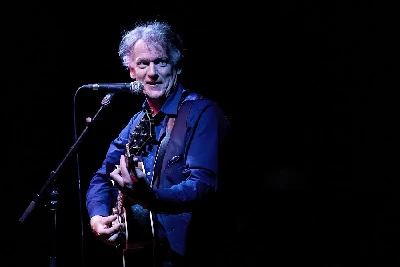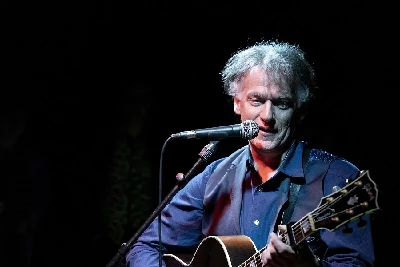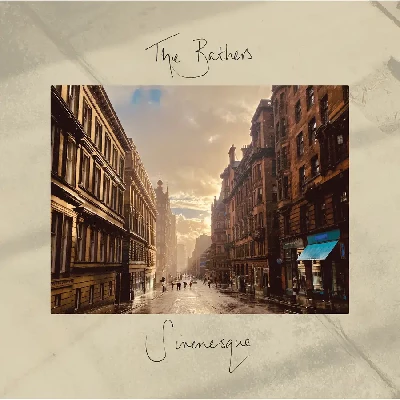Bathers
-
Interview with Chris Thomson
published: 8 /
3 /
2024

Chris Thomson, the frontman with acclaimed Scottish act The Bathers, speaks to John Clarkson about their first album in 24 years,, 'Sirenesque'.
Article
The Bathers have released some of the most beautiful and evocative albums ever recorded by a Scottish act.
They were formed in 1985 by Chris Thomson after the break-up of his previous band, the short-lived but fondly remembered Friends Again, which also featured James Grant and Paul McGeechan who went on to form Love and Money.
While originally conceived as a project for vocalist, guitarist andpianist Thomson with a rotating cast of players, The Bathers’ line-up has stabilised in recent years to also feature remarkable soprano drummer Hazel Morrison and electric guitarist Callum McNair. The group recorded six albums of impassioned, literate rock in the 1980s and 1990s, which found Thomson working at points with strings’ sections and on their 1995 acclaimed fourth album ‘Sunpowder’ with The Cocteau Twins’ Elizabeth Fraser.
Now, after an absence of 24 years, The Bathers have returned with their first album of new material, ‘Sirenesque’. It has many of the hallmarks of previous Bathers’ records, Thomson’s Tom Waits-ian style burr, Morrison’s ethereal backing vocals and the sweeping, epic soundscapes, but is a step up, finding them working with two orchestras, the Prague Philharmonic Orchestra on ‘Feathers, Books and Lace’, and the recently formed Scottish Session Orchestra on its other eleven tracks.
Chris Thomson has also been working with McGeechan on his project Starless’s third album, 'Returning Home’, which is due out in April. We spoke to Chris Thomson about ‘Sireneaque’.
PB: It has been 24 years since your last album, ‘Pandemonia’. Did you intend to take such a long hiatus in 1999 after you put out that record?
CHRIS THOMSON: It is shocking when you put it like that (Laughs). No. Life takes over. I got married, and had kids. Particularly when my daughter was very small, I was on the John Lennon route, and basically a house husband.
I remember when she was about three she was at nursery for about two and a half hours each day, and I thought, “Wow! I can get so much done,” and, of course, you don’t. By the time I had got home and had had a coffee, it was time to go and collect her again (Laughs). I did love that phase though. It was a lovely thing to do and be around.
During that period, I did, however, work away a little on the piano we have here, and the germ of some of those ideas and the melodies that I was messing about with made it onto the record over twenty years later. Some of them certainly made it through.
PB: So how many of these tracks are recent and how many of them go back to then?
CT: Only fragments of those ideas are in the songs. It is fresh in a lot of ways. A day or two before we sent the vinyl master for mixing to Paul McGeechan, I did one vocal at the very last minute, All the vocals were done in the final six months or so. It started to gain a lot of traction on it in this last year.
I was really helped by working with Paul McGeechan on his Starless project It gave me the confidence of actually completing a song, partially because I was doing it for him.
Until then we just had parts of pieces. Some of the instrumentals and string pieces were done as long ago as four or five years, and I knew that I had to make songs out of some of them. It felt a little bit intrusive at first (Laughs), but I had to get over that and crack on. I didn’t want to make an instrumental album particularly. Once you are a certain way into that process, you realise that “I need more of this” or “I need more of that,” so other bits of music came on board. There is a lot of moving parts around, and you feel like you are going backwards at times, but then eventually you feel like you are gaining momentum and enough pieces of the jigsaw that the whole picture is starting to emerge.
I had roughly 80% of the album ready in the year leading up to its release. It was just a case of finessing things and performing the vocals to a satisfactory level after that.
PB: Did the lyrics always come last?
CT: Pretty much. I don’t always work that way. The exception is ‘Lost Bravado’. I set myself the challenge of writing a song a day, just as an exercise. I did it for about ten days or so, and that came from those sessions. It just originally featured my voice and me jamming it out on an acoustic guitar, and then I thought that it would be good to do it with strings.
The other that is closest behind that is ‘Feathers, Books and Lace’. I was working on some stuff for the Starless project, and initially I had iti n mind for Paul and then it became too Bathers-like very quickly (Laughs).It fitted perfectly onto the second side of ‘Sirenesque’. That track was, however, written on piano with most of the words coming quickly afterwards.
PB: Was that track recorded in Prague when you were there with Paul?
CT: That was in April. I was prepared to use a version with piano and double bass, which will no doubt see the light of day as a lost track release or something, but when the opportunity came up to go to Prague, I thought, “Okay, I have got nothing to lose.” We were out there anyway and Paul kindly said, “There is probably a bit of spare studio time with a 24-piece orchestra plus a harp player if you want to use it,” so that was an easy decision to make to give it a go out there. Much as I like the low-key version, the strings won out.
PB: ‘Sirenesque’ is your most orchestral album. You have worked with violin and viola players before, but this is the first album which employs orchestras on all tracks. How much of that came about because you had worked with Paul on Starless?
CT: Apart from ‘Feathers, Books and Lace’, not at all. By coincidence I had played a gig back in 2016 at the Mackintosh Church in Glasgow and I used a cello player called Maya Burman-Roy, who introduced me to a guy called Kobus Frick, who is originally from South Africa but has been in Glasgow for a long time. He came and played violin at that gig, and it just so happened that he was trying to set up a Scottish-based orchestra with all the top players who would be guns for hire for film TV or projects like mine, so I was in there on day one.
I was almost the guinea pig. We got three or four tracks at the first session. It was just pure luck. I was thinking of maybe using a string quartet, an octet, something like that, and this was what became the Scottish Session Orchestra.
PB: How many days did you get with them?
CT: Not many. They are used to working at breakneck speed, so it was more a case of how many minutes you get with them (Laughs). They would be working in something like a four-hour block, and in most cases I got a one-hour block with each song. We got a couple of runs at it, but they don’t tend to make mistakes. They are absolutely amazing and very fast.
PB: That must have been intense.
CT: Yes, it was very intense, The clock is ticking, and even with a deal you are burning money. It is a good way to work. It was like in the old days when you went through to a studio and had very limited time. I found it quite refreshing.
PB: That must have been quite a contrast to the way you recorded ‘Trapped and Unwrapped’, the Friends Again album.
CT: It is one of my biggest regrets the time we squandered in studios with Friends Again. It wasn’t that unusual an experience.for bands in the 1980s. We were in RAK in St John’s Wood and really we should have done three albums in the time we were there.
PB: You were still in your thirties when you recorded ‘Pandemonia’. Since then, as you have said your life has changed. You have got married and have kids. DO you think the blueprint for your lyrics have changed much?
CT: I think that the lyrics are much more widescreen. It cuts and sweeps between personal scenarios and experiences, but they quickly sweep out to something more central and universal. I suppose that you could use the term ‘cinematic’. I think that it is something that I have maybe touched upon in the past with writing but I just seemed to take it to a very different level of writing this time.
PB: You are singing as someone who is older now. The lyrics seem to be much more reflective of time passing.
CT: That is very true. I have got sixty years plus of experiences to look back on. There are fragments of childhood memories and every part of life experience in there, and also what I have observed from music and books and film and places. It would be hard for even me to know what is from where because they merge and twist and turn in all sorts of ways.
PB: It is impossible to put The Bathers into a category these days because you fall somewhere between being a rock group and a classical ensemble.
CT: It is getting trickier and trickier, especially on this record because it is so highly orchestrated. Luckily it is not my job. The kind of comparisons that are floating around are deliberately quite vague by journalists.They can see an element of this or that, but it inhabits its own space I think. I have been around long enough so that I am not striving to be something that is alien to me. I am following quite an instinctive path of doing my own thing, and by working with the incredible talents of the other Bathers such as Hazel Morrison and Callum McNair who have transcended their own influences. It stands in recognisably its own form.
PB: The cover art is fantastic. Who did that?
CT: I took the picture myself on my iPhone. I just got lucky. I was on a climate change march in Glasgow a couple of years ago and just as we passed down West George Street - the picture was actually taken looking down Hope Street - and then suddenly the grey sky just disappeared and it just cleared. I just happened to be standing at the top of that street and there was very little traffic as the road was closed, and I shot pictures very quickly, and I just managed to capture that moment.
It is classically quite a timeless scene, but it is also classically Glasgow which is home town for me. It has a nice resonance. You have got the classical buildings, but also the mystery of where this light came from. I had the picture and I liked it so when it came to working up the sleeve we had half a dozen images to play with from different scenarios but this was the one that came together.
PB: Your launch gig for ‘Sirenesque’ in October saw you on stage with both James Grant and Paul McGeechan for the first time since Friends Again broke up. There has been much talk of a Friends Again comeback gig, but Neil Cunningham and Stuart Kerr, the other members, have not been involved in music in a long time. Is that as close as things get?
CT: We first talked about a Friends Again reformation gig just before the lockdowns began, and that put a kibosh on it. I have got to say that it was such good fun to play on ‘Honey at the Core’ and ‘State of Art’ with James.
It came about because John McTaggart who runs the Woodside Hotel in Aberdour, where The Bathers have played several gigs. was having his sixtieth birthday party a few months ago, and I went along as a guest, and who did I bump into in the car park but James. James was there as the surprise musical guest, and as soon as I said, “Lovely surprise. How are you doing?” he said, “Do you fancy jumping up for ‘State of Art?” I said, “Absolutely”. It was sheer luck that I happened to be in the car park at the time, and if I had been in the audience he wouldn’t have known I was there.
So, we did that song, and then a few weeks later we got together for a coffee, and I said, “James, I am doing this gig in Glasgow and, if you are free, do you fancy doing a couple of songs?” and he said, “Yeah! Sounds like fun!” And there it was. It was so relaxed I would love to do a more full-on hour’s worth of Friends Again songs. I will see how the others feel about. and if we can make it happen I would love to do it.
PB: Final question! You have finally got this album out. What are you plans for 2024?
CT: I will certainly be helping Paul out with the forthcoming Starless record. We have got the launch gig at the Debating Hall in Glasgow. I will be one of the guest singers.
At the same time we will be really looking to do as many gigs as we can to promote the ‘Sirenesque’ record. It is definitely the kind of soundscape that people can really choose to enjoy over a long period of time. It would, therefore, be nice to keep pushing that record as much as we can and making the songs come alive in a live setting too.
PB: Thank you.
Photos by Philip Wark
Band Links:-
https://www.facebook.com/kelvingrovia/
https:/x.com/thebathersoffi1
https://thebathers.bandcamp.com/
https://www.instagram.com/the_bathers/
Play in YouTube:-
Have a Listen:-
Picture Gallery:-



